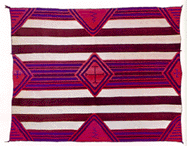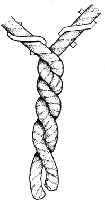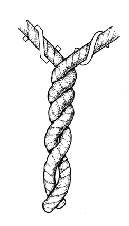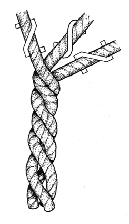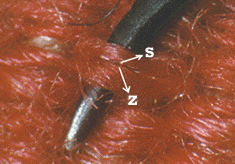Plied
yarns from Navajo Textiles are explained.
Analysis
of Navajo Textiles Shows
these pre-1900 textiles
frequently have Raveled Yarns.
Examples of raveled yarns
Twist refers to the group of plied yarns and the direction they are twisted together i.e., S or Z. Spun or spin refers to the individual yarns incorporated into the larger group and the direction of spin i.e., S or Z.
These
yarns are samples of the labor intensive process the Navajo employed
to create the red yarns for their weavings-most common before 1880.
The process visually outlined above also illustrates the problem
of analyzing one red color. If there are several different
yarns present in a weaving then there are probably several different
dyes with the different yarns. Early dye analysis ignored
the yarn's details in favor of just testing "the red color"
and has frequently produced results that claim blends of Lac
and cochineal or there were confused
results because the testing could not separate or identify two dyes
present in one sample. This is significant because there probably was a yarn comprised of two different flannels and then the smaller yarns are raveled out from the flannel and made into a new red yarn, as we can see in the photo above from two different bolt cloths or flannel. This one red yarn had two smaller yarns containing different dyes when tested separately. We have frequently found each different yarn to contain different dyes. In the past this was not done and the dye analysis provided "mixed" results. We have the opportunity to analyze and identify the variations and clues left in the physical evidence as to what the weaver collected, saved, or incorporated from different sources. Microscopic analysis of the yarns is the only way to realize the opportunity and follow up with hypotheses to direct the research into testing different yarns found re-twisted together. A complete and thorough examination is required and careful notation and mapping on a drawing of the textile is how we build a report of where and what was found. This kind of careful examination allows the textile to be conceptually reconstructed and analyzed not just appraised of its value. We can learn what went into the textile and reveal the complex historical trade routes, fabrication processes, and ethnological clues as the evidence builds. There is a lot we can learn from studying the yarns, dyes, and fibers. Information: mailto:infoMI@material-insight.com |
